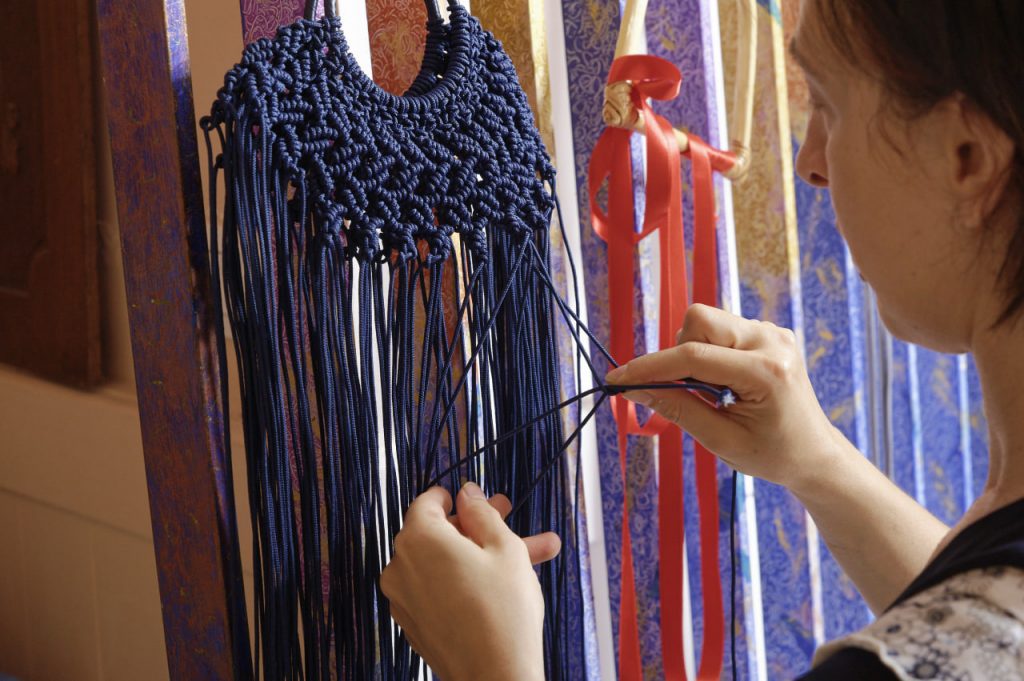Macrame is not just about knots—it’s about the patterns that emerge when these knots are combined in different ways. As you advance in your macrame journey, you’ll begin to experiment with more intricate designs and personalized projects. In this article, we’ll explore various macrame patterns that will take your skills to the next level and inspire new creative projects.
What Makes Macrame Patterns Unique?
Macrame patterns are built through the repetition of specific knots and their placements. The patterns you create depend on how you combine these knots, the type of material you use, and the style you’re aiming for. These patterns can range from simple geometric shapes to complex, flowing designs. They add texture, depth, and visual interest to your macrame pieces.
Popular Macrame Patterns to Try
Here are some classic macrame patterns to try in your next project. These patterns can be used in various items like wall hangings, plant hangers, bags, and even jewelry.
- Chevron Pattern
The chevron pattern is a striking V-shaped design that gives a bold and structured look to any macrame project. To create a chevron pattern, you’ll need to use the basic Square Knot and alternate the direction of the knots to form the V-shape. This pattern is perfect for wall hangings and throws. - Spiral Knot Pattern
This pattern creates a beautiful twisting effect, ideal for items like necklaces, bracelets, and keychains. The Spiral Knot pattern is made by creating alternating Half Hitch knots that naturally spiral around the cords. It’s a wonderful way to add a flowing, dynamic look to your project. - Feather Pattern
The feather pattern is one of the most creative and decorative macrame designs, often used in wall hangings and dreamcatchers. It involves layering Lark’s Head Knots and Square Knots to mimic the appearance of delicate feathers. The beauty of this pattern lies in the fringe created at the bottom, adding texture and dimension. - Diamond Pattern
Diamonds are a staple design in macrame, especially when creating larger projects like wall hangings or room dividers. The Diamond pattern often uses a combination of Square Knots and Diagonal Knots arranged in such a way that they form a clean, symmetrical diamond shape. This pattern can be used alone or combined with others to add complexity to your designs.
How to Incorporate Patterns into Your Projects
Once you understand the basic patterns, you can incorporate them into various macrame projects. Here are some ideas:
- Macrame Wall Hangings: Create a stunning feature piece for your home by combining different patterns, such as Chevron and Diamond, into a large wall hanging.
- Plant Hangers: Add a unique twist to a traditional macrame plant hanger by incorporating Spiral Knots or Feathers to create an eye-catching design.
- Macrame Bags: Use geometric patterns like the Diamond design to create a beautiful macrame bag. The combination of knots creates a sturdy yet stylish item.
- Macrame Jewelry: Experiment with delicate patterns, such as Spiral Knots or simple Square Knot variations, to create unique necklaces, bracelets, and earrings.
Tips for Creating Your Own Macrame Patterns
If you’re feeling creative, try designing your own macrame patterns. Here’s how:
- Mix and Match Knots: Combine different knots in innovative ways. Try layering a Square Knot with a Half Hitch Knot to create new visual effects.
- Play with Cord Lengths: By varying the lengths of your cords, you can create asymmetrical or geometric designs that add intrigue to your project.
- Add Color and Texture: Don’t limit yourself to just one type of cord or color. Combining different textures, such as thick and thin cords, or using color gradients, can add more depth and dimension to your patterns.
- Experiment with Spacing: The distance between knots can significantly impact the final pattern. Wider spacing will create a more airy, open design, while closer spacing will result in a dense, intricate pattern.
Why Macrame Patterns Are Important
Creating and following macrame patterns is an essential part of developing your skills as a macrame artist. Patterns bring structure to your work, making it possible to design anything from simple decorative items to complex, multi-layered pieces. By learning different patterns, you not only expand your creativity but also gain the ability to transform a piece of cord into an intricate and beautiful work of art.
Final Thoughts
Macrame is an incredibly flexible craft that allows you to experiment and explore various patterns. Whether you’re adding a simple chevron design to a plant hanger or diving into the complexity of a feather pattern for a wall hanging, each design offers endless possibilities for creativity. Keep practicing these patterns, and soon enough, you’ll be creating your very own unique macrame designs that reflect your personal style.
The beauty of macrame is that there are no limits to the patterns you can create, making it a perfect craft for those who love to experiment and push creative boundaries. Happy knotting, and enjoy the process of weaving your own intricate patterns!

